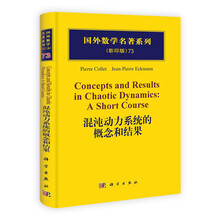混沌动力系统的概念和结果

目 录内容简介
1 A Basic Problem
2 Dynamical Systems
2.1 Basics of Mechanical Systems
2.2 Formal Definitions
2.3 Maps
2.4 Basic Examples of Maps
2.5 More Advanced Examples
2.6 Examples of Flows
3 Topological Properties
3.1 Coding, Kneading
3.2 Topological Entropy
3.2.1 Topological, Measure, and Metric Spaces
3.2.2 Some Examples
3.2.3 General Theory of Topological Entropy
3.2.4 A Metric Version of Topological Entropy
3.3 Attractors
4 Hyperbolicity
4.1 Hyperbolic Fixed Points
4.1.1 Stable and Unstable Manifolds
4.1.2 Conjugation
4.1.3 Resonances
4.2 Invariant Manifolds
4.3 Nonwandering Points and Axiom A Systems
4.4 Shadowing and Its Consequences
4.4.1 Sensitive Dependence on Initial Conditions
4.4.2 Complicated Orbits Occur in Hyperbolic Systems
4.4.3 Change of Map
4.5 Construction of Markov Partitions
5 Invariant Measures
5.1 Overview
5.2 Details
5.3 The Perron-Frobenius Operator
5.4 The Ergodic Theorem
5.5 Convergence Rates in the Ergodic Theorem
5.6 Mixing and Decay of Correlations
5.7 Physical Measures
5.8 Lyapunov Exponents
6 Entropy
6.1 The Shannon-McMillan-Breiman Theorem
6.2 Sinai-Bowen-Ruelle Measures
6.3 Dimensions
7 Statistics and Statistical Mechanics
7.1 The Central Limit Theorem
7.2 Large Deviations
7.3 Exponential Estimates
7.3. I Concentration
7.4 The Formalism of Statistical Mechanics
7.5 Multifractal Measures
8 Other Probabilistic Results
8.1 Entrance and Recurrence Times
8.2 Number of Visits to a Set
8.3 Extremes
8.4 Quasi-lnvariant Measures
8.5 Stochastic Perturbations
9 Experimental Aspects
9.1 Correlation Functions and Power Spectrum
9.2 Resonances
9.3 Lyapunov Exponents
9.4 Reconstruction
9.5 Measuring the Lyapunov Exponents
9.6 Measuring Dimensions
9.7 Measuring Entropy
9.8 Estimating the Invariant Measure
References
Index
2 Dynamical Systems
2.1 Basics of Mechanical Systems
2.2 Formal Definitions
2.3 Maps
2.4 Basic Examples of Maps
2.5 More Advanced Examples
2.6 Examples of Flows
3 Topological Properties
3.1 Coding, Kneading
3.2 Topological Entropy
3.2.1 Topological, Measure, and Metric Spaces
3.2.2 Some Examples
3.2.3 General Theory of Topological Entropy
3.2.4 A Metric Version of Topological Entropy
3.3 Attractors
4 Hyperbolicity
4.1 Hyperbolic Fixed Points
4.1.1 Stable and Unstable Manifolds
4.1.2 Conjugation
4.1.3 Resonances
4.2 Invariant Manifolds
4.3 Nonwandering Points and Axiom A Systems
4.4 Shadowing and Its Consequences
4.4.1 Sensitive Dependence on Initial Conditions
4.4.2 Complicated Orbits Occur in Hyperbolic Systems
4.4.3 Change of Map
4.5 Construction of Markov Partitions
5 Invariant Measures
5.1 Overview
5.2 Details
5.3 The Perron-Frobenius Operator
5.4 The Ergodic Theorem
5.5 Convergence Rates in the Ergodic Theorem
5.6 Mixing and Decay of Correlations
5.7 Physical Measures
5.8 Lyapunov Exponents
6 Entropy
6.1 The Shannon-McMillan-Breiman Theorem
6.2 Sinai-Bowen-Ruelle Measures
6.3 Dimensions
7 Statistics and Statistical Mechanics
7.1 The Central Limit Theorem
7.2 Large Deviations
7.3 Exponential Estimates
7.3. I Concentration
7.4 The Formalism of Statistical Mechanics
7.5 Multifractal Measures
8 Other Probabilistic Results
8.1 Entrance and Recurrence Times
8.2 Number of Visits to a Set
8.3 Extremes
8.4 Quasi-lnvariant Measures
8.5 Stochastic Perturbations
9 Experimental Aspects
9.1 Correlation Functions and Power Spectrum
9.2 Resonances
9.3 Lyapunov Exponents
9.4 Reconstruction
9.5 Measuring the Lyapunov Exponents
9.6 Measuring Dimensions
9.7 Measuring Entropy
9.8 Estimating the Invariant Measure
References
Index
目 录内容简介
《混沌动力系统的概念和结果》介绍了混沌动力系统的概念和其拓扑性质、双曲率、不变测度、熵和其他概率结果。
比价列表
公众号、微信群
 缺书网
缺书网微信公众号
 扫码进群
扫码进群实时获取购书优惠





